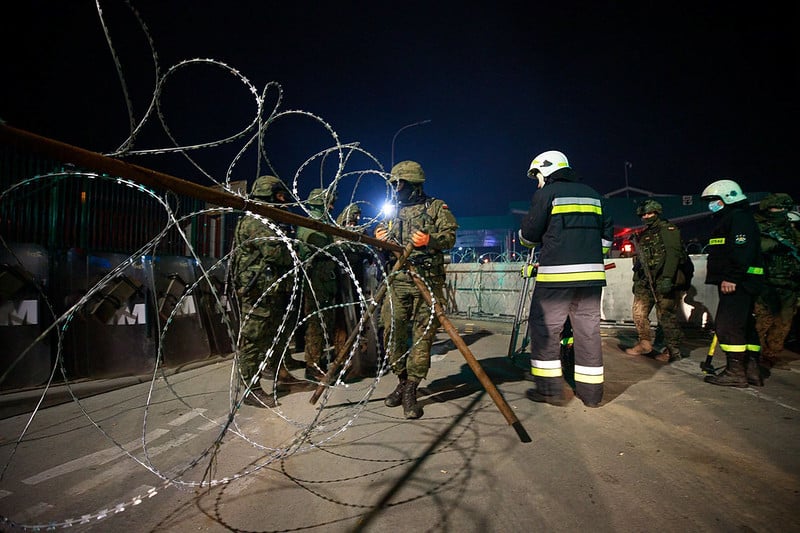Polish defence forces securing the fence at Kúznica, Poland (Flickr, 2021)
The use of migrants as a destabilising form of “hybrid warfare” was already causing a standoff between Belarus and EU member states Poland and Lithuania. With a kilometre-long wall erected between these countries, Poland is now turning its sights on the Russian enclave of Kaliningrad, where Warsaw expects a similar threat.
Poland plans to build wall on the border with Russia
Poland borders Russia because of the Russian enclave of Kaliningrad. A place increasingly isolated by the sanctions that followed Russia’s invasion of Ukraine. Consequent sanctions and condemnation of the war launched by Russia have put Kremlin-EU relations on the back burner. With the resulting tensions, Warsaw does not rule out Russia’s use its enclave to destabilise Poland and Lithuania through setting up illegal immigration flow. Polish Defense Minister Mariusz Blaszczak has therefore ordered the construction of a temporary wall between Poland and Kaliningrad. According to Blaszczak, the measure to ‘seal this border’ followed after the Russian aviation authority Rosaviatsiya recently decided to launch new flights between the Middle East and North Africa to Kaliningrad.
Belarusian-Polish border as an example
The Polish decision to counter the use of illegal migrants as a method of destabilisation with a border wall is identical to what happened earlier on the border with Belarus. Since July 2021, Alexander Lukashenko, the de facto dictator of Belarus, has been abusing migrants by actively bringing them into Belarus and escorting them to the borders with EU member states Lithuania, Latvia and Poland. For Lukashenko, this method of destabilisation, part of what is often called hybrid warfare, is a retaliation for European sanctions and the discrediting of his regime following the fraudulent elections in Belarus in August 2020.
With illegal pushbacks, an entry ban on Polish activists and the construction of a 5.5-metre-high wall on its border with Belarus, Poland has taken drastic measures against the influx of migrants. The resulting skirmishes at the border were not only humiliating, but also led to the deaths of 24 refugees. The wall did not prevent dozens of refugees from crossing the border. Human rights activists say the wall even contributed to making the situation worse: many refugees severely injured themselves while climbing the wall.
Poland’s intervention prevented fewer migrants from entering the country. For whom the situation is far from resolved are the migrants stuck in poor conditions in Belarus, where they are exposed to human rights violations such as mistreatment by police and receive insufficient care. As a result, the situation for these refugees remains as dramatic as ever, although Europe seems to have long forgotten about them. As Europe focuses on the millions of Ukrainian refugees scattered across Europe since February 2022, refugees from other conflict-torn areas such as Yemen, Syria and Iraqi Kurdistan in Belarus are increasingly neglected.
“Fortress Europe” expansion
With the lessons learned from the situation on the Polish-Belarusian border, it remains to be seen whether a wall between Kaliningrad and Poland will help prevent a similar situation. That drastic measures like this were to be expected can hardly be doubted. “Fortress Europe” continues to expand, with new fortifications on both the continental internal and external borders. The deplorable situations at the borders with Turkey, partly caused by European policies, and the migrant deal concluded in 2016 is perhaps the best-known example of how Europe guards its borders. Numbers of incoming refugees are central to this, how to keep this number as low as possible is secondary.
With migrants also being used as destabilisation mechanisms, their fate has become secondary to achieving strategic goals. Through hybrid warfare, the process of dehumanising the refugee has been taken even further. The true victim of this warfare is not the Polish economy or socio-political stability within the European Union, but is the refugee who has fallen into oblivion.
Although there is no refugee flow from Kaliningrad to neighbouring areas yet, the wall between Poland and Kaliningrad is the next extension of “Fortress Europe”. The European Union is reacting reluctantly to the brutal way refugees are being stopped. For Western European countries, preventing these flows is also in their own interests. In doing so, the end seems to justify all means.
When the Berlin Wall was torn down 23 years ago, and after the fall of the Iron Curtain, Europe seemed headed for a future in which borders were blurred. However, the present shows that building a wall is still one of the first solutions by which Europe combats tensions. Until Europe itself has a unified strategy to deal with refugees humanely, this form of hybrid warfare remains an option for malicious regimes like Lukashenko’s to destabilise. Whether Putin will also use Kaliningrad in this way remains to be seen.
Author: Mathieu Neelen
Sources: CarnegieEurope, DeutscheWelle, EuroNews, Reliefweb, UNHCR
Photo: Flickr



